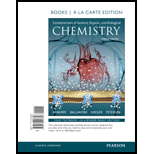
Concept explainers
Interpretation:
The difference between
Concept Introduction:
Ideal gas Equation:
Any gas is described by using four terms namely pressure, volume, temperature and the amount of gas. Thus combining three laws namely Boyle’s, Charles’s Law and Avogadro’s Hypothesis the following equation could be obtained. It is referred as ideal gas equation.
Where,
Combined gas law:
Different laws have been put forward to introduce properties of gases:
Boyle’s law:
At fixed temperature, the volume of a fixed amount of gas is inversely proportional to the pressure exerted by the gas.
Charles law: States that volume is directly proportional to temperature when the gas is held
at constant pressure and number of molecules.
General Gas Law: Combining Charles’s law and Boyle’s law we get the General gas law or Combined gas law.
Want to see the full answer?
Check out a sample textbook solution
Chapter 8 Solutions
Modified Masteringchemistry With Pearson Etext -- Valuepack Access Card -- For Fundamentals Of General, Organic, And Biological Chemistry
- What are some advantages of gas exchange in air over gas exchange in water?arrow_forwardWhat is the amount of these gases ( O2 , N2O , Air 4 bar , Air 7 bar ) that should the patient receive in hospital ?arrow_forwardWhat is hospital pipeline pressure and What is the appropriate gas pressure to deliver to a patient in the hospital?arrow_forward
 Biology (MindTap Course List)BiologyISBN:9781337392938Author:Eldra Solomon, Charles Martin, Diana W. Martin, Linda R. BergPublisher:Cengage Learning
Biology (MindTap Course List)BiologyISBN:9781337392938Author:Eldra Solomon, Charles Martin, Diana W. Martin, Linda R. BergPublisher:Cengage Learning Principles Of Radiographic Imaging: An Art And A ...Health & NutritionISBN:9781337711067Author:Richard R. Carlton, Arlene M. Adler, Vesna BalacPublisher:Cengage Learning
Principles Of Radiographic Imaging: An Art And A ...Health & NutritionISBN:9781337711067Author:Richard R. Carlton, Arlene M. Adler, Vesna BalacPublisher:Cengage Learning- Basic Clinical Lab Competencies for Respiratory C...NursingISBN:9781285244662Author:WhitePublisher:Cengage




